
Volume XVII, Issue XXII, XXIII, XXIV: Crozet's Railroad
Today’s TRIPLE ISSUE gives you several weeks’ reading as I step back from weekly publication to devote myself to several important projects. I hope you enjoy it.
Claudius Crozet's Railroad Tunnels
Photos by Carrie Austin Eheart

Little Rock Tunnel, at 100 feet it is the shortest in a series of tunnels through the Blue Ridge Mountains.

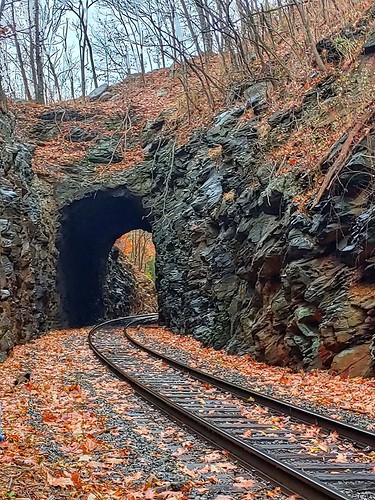
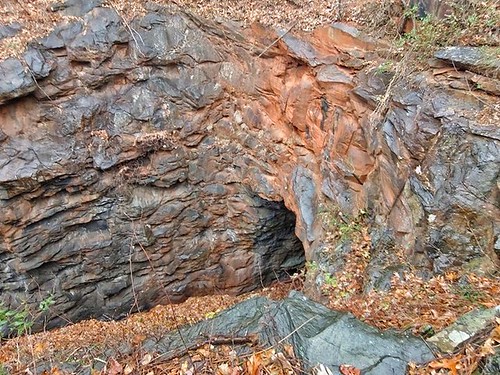


Hand excavated approaches to the Little Rock Tunnel.
Life is like a mountain railroad
With an engineer that's brave
We must make the run successful
From the cradle to the grave
Watch the curves, the fills, and tunnels
Never falter, never fail
Keep your hand upon the throttle
And your eyes upon the rail
Blessed Savior, Thou will guide us
Till we reach that blissful shore
Where the angels wait to join us
In that great forevermore
As you roll across the trestle
Spanning Jordon's swelling tide
You'll behold the Union Depot into which your train will glide
There you'll meet the superintendent
God the Father, God the Son
With a hearty joyous greetings:
“Weary Pilgrims Welcome Home”
— Life’s Railway to Heaven, In 1890, Charles Davis Tillman set to music a hymn by Baptist preacher M.E. Abbey, “Life's Railway to Heaven.” (Abbey had drawn from an earlier poem, “The Faithful Engineer,” by William Shakespeare Hays).

The Greenwood Tunnel.



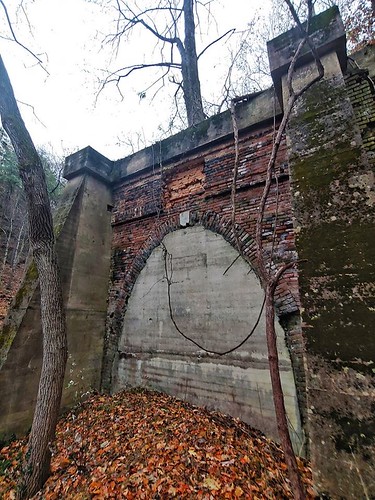



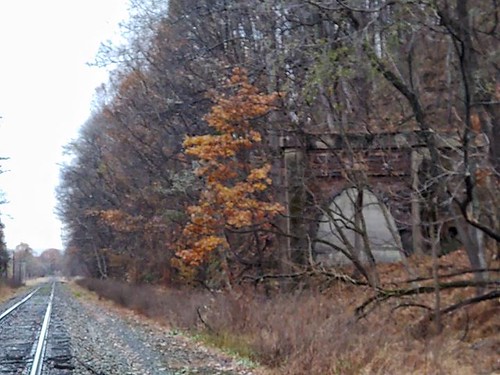
Photos by Carrie Austin Eheart.
Buckingham Branch Railroad Follows Historic Path
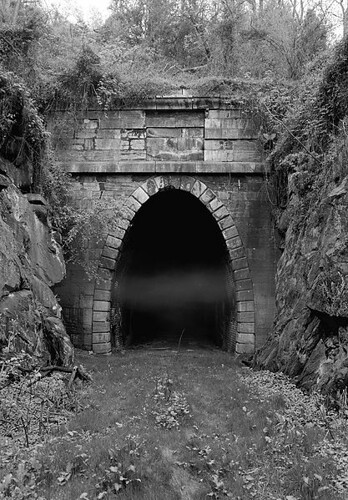
Claudius Crozet's Original Blue Ridge Tunnel. Library of Congress Image.
More than 150 years ago about 2,000 Irish immigrants changed the face of Augusta County. For eight years they joined with over 100 African-American slaves and, by hand, dug 4,262 feet through the rock of Afton Mountain to built a railroad tunnel. When they were finished in the 1850s, Richmond was connected by railroad to Staunton and Nelson County and Augusta County were connected underneath the mountain by the same rock tunnel. Some of those Irish who constructed this engineering marvel stayed in the Valley where they built a church—St. Francis Catholic Church—as well as homes, and businesses.
The story of those Irish, the African Americans, and the tunnel they built are remembered by Clann Mhór. Clann Mhór started as a research group dealing with the construction of the original Blue Ridge Railroad line that ran the 17 miles from the Mechum's River (near Ivy, Va.) up through the mountains to the South River in Waynesboro. They have evolved to include the continuation of the railroad construction further west to Staunton and Clifton Forge. Key to understanding the railroad history of the region is learning about the Irish workers hired to construct the line. Researchers with Clann Mhór, which means Great Family in Gaelic, have collected the names of over 1,900 Irish workers and their families and 100 slaves associated with the railroad. At least 941of the workers were native Irish coming mainly from the counties of Cork, Kerry, and Limerick. The men building the tunnel by hand worked six days a week, for about one dollar a day.
Using records from the C and O Historical Society, Thornrose Cemetery, and early Staunton newspapers, as well as Augusta County Courthouse records including marriages, deaths, citizenship applications, and census records, Clann Mhór has been able to document a rich picture of the lives of the railroad workers.

St. Francis Catholic Church, Staunton, Virginia. Painting by Bob Kirchman.
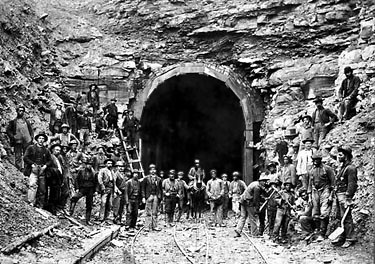
This 19th century photo of the tunnel and the workers was taken on the western, Augusta County, side of the tunnel. Today the original tunnel awaits restoration into a regional greenway open to walkers and cyclists. Trains still pass through the mountain by way of a newer tunnel constructed in 1942 [1.]

Claudius Crozet surveys the opening of the Blue Ridge Tunnel in a mural by Bob Kirchman and John Pembroke, restored by Kristina Elaine Greer and Meg West in 2012.

Elliott Knob in Augusta County. The tracks heading West to Clifton Forge wind around the base of this mountain. Painting by Bob Kirchman.
Riding Through History on the Buckingham Branch
The Virginia Central Railroad was a major feat of engineering in its day as Claudius Crozet built a series of four tunnels under the Blue Ridge Mountains in 1856. Today the crews that operate the Buckingham Branch Railroad carry on the tradition.
We're riding on BB6, a GP40 diesel-electric locomotive, out of The Flats. Our crew, Don and Zane, are making the run across the mountain to Charlottesville. A number of businesses along the track depend on the railroad for bulk shipments.
We roll through Staunton and make our way to Transit Mix Concrete to deliver a car. Although much of a railroad's operation is computerized, the process of making up trains and taking them apart is still a mixture of chess game, choreography and hard work on the part of the train crew.
Switches must be unlocked and thrown, hand brakes set and unset and safety measures attended to. It looks like fun on a balmy october day as Zane moves about performing these tasks, but you have to imagine what it is like when he's doing the same job in last Winter's big snow or driving rain. A railroad man's job was tough in the Nineteenth Century and this part of it hasn't changed.
It takes a bit of leverage to throw a switch on a good day, so think of what it must be like when snow is piling up around you. We back into the first siding. It has tight curves that make for slow going. We've left most of our cars on the main line and are pushing the cement car into place. Then we need to return and couple up those we've left. We pull forward and back the entire train onto the Transit Mix siding to clear the track for a Westbound CSX train. The switch must be opened for the main line and locked before the track is considered clear.
Then you wait. Safe operation depends on constant communication and a permitting system to ensure that no Eastbound train tries to share a track with a Westbound. There are work trains to be accounted for too. A long line of empty coal cars passes. When the track is cleared we begin again. Our next stop is Augusta Coop. We will be bringing them another car from Charlottesville, so we drop one car for them on their siding. We'll put it in the fertilizer pit area later when we return.
Now we make our way out to Fishersville. We roll through Waynesboro and Basic City. We start climbing the mountain and enter the almost mile-long Blue Ridge Tunnel. This is a parallel tunnel to Crozet's original Blue Ridge Tunnel that was built in 1942 for larger wartime rail cars. We emerge at Afton and head down seven miles of descending grade that will take us to the town of Crozet.
The train moves through a series of tight curves where the track follows the original route, You can imagine what it must have been like to cut that grade through the stone by hand. We move through this section under 25 miles per hour. The Rock tunnel is next. Here is an uncased tunnel that was built by Crozet. It looks about the same as it did in the Nineteenth Century.
We pass through open cuts where the Greenwood tunnel and another tunnel have been bypassed. Then its on through Crozet. We pass the now defunct Westvaco wood lot in Ivy. "This would be a great place for a business," Don says. "Good luck on that, this is Albemarle County," I reply. When I lived in Crozet, some of my neighbors worked for Westvaco. There were the Morton's Frozen Foods plant and Acme Visible Records plant in the town itself. Both are shuttered now as well.
We enter Charlottesville where the train must crawl through town at 10 miles per hour and cannot blow her horn at grade crossings. I muse to Don about UVA students who cross streets [and railroad tracks] without looking: "What do you do about them," I ask. "You have to be ready to stop" is his answer. You are allowed to sound the horn in an emergency.
We switch cars in the Charlottesville yard by the fading evening light. There is a little preschool by the entrance to the yards and it gives me great pleasure to sit in a locomotive cab and wave to the kids. The teachers hold up some of the little guys to get a better look. I wave some more as we pass the school several times. I remember in my youth the Maryland and Pennsylvania Railroad had a track near our house. I liked to watch that train.
It is dark as we crawl back out of Charlottesville. Don spots a grey fox sitting on the track near the University of Virginia. He runs off and we spot a hole near the track. Later I spot an owl flying overhead as we run through Albemarle County. Deer are everywhere.
We return to Brand, just East of Staunton, where we shuffle around the other car we've picked up for Augusta Coop and push it into their siding. It's around 9:30pm when we return to the flats. There is paperwork to do for the crew. I pick up Don's bag of required operating manuals -- it is heavy. I'm grateful to have seen a part of the culture that built this country and to have shared it with the men who still live it.
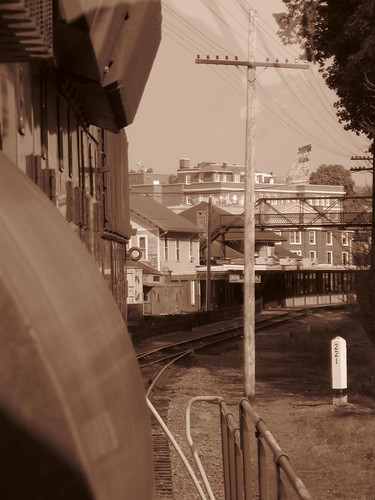
BB6 Leaves the flats and heads through Staunton.
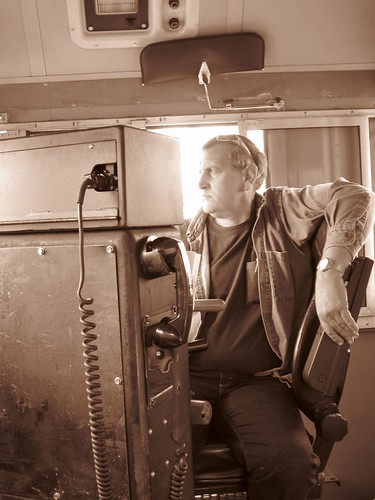
Don driving BB6.
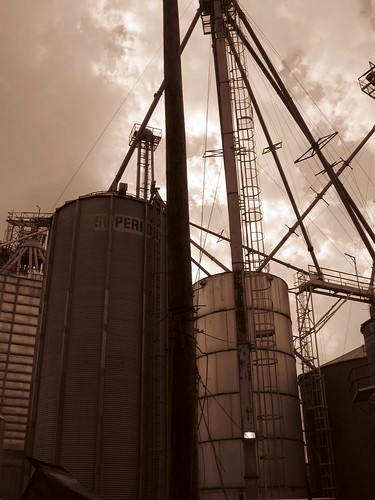
Augusta Coop.
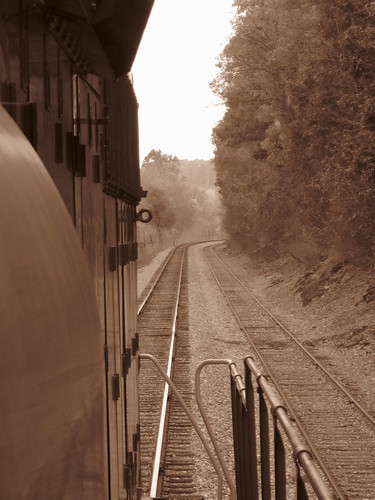
Rolling through Brand, heading East.
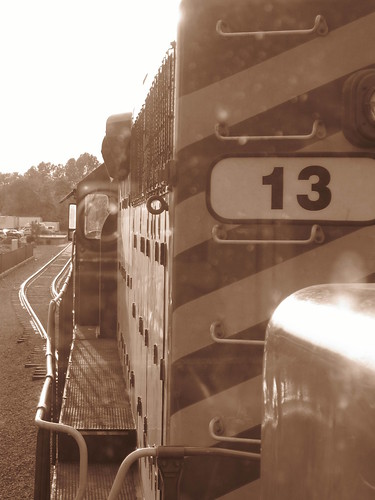
BB13.
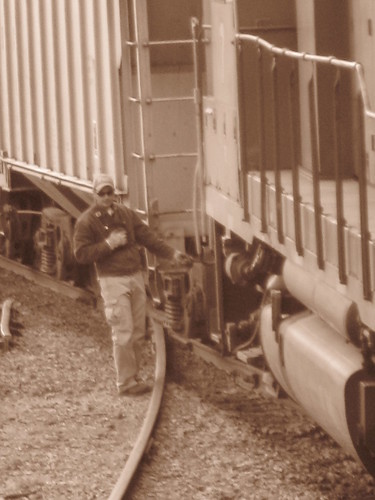
In the Charlottesville Yard.
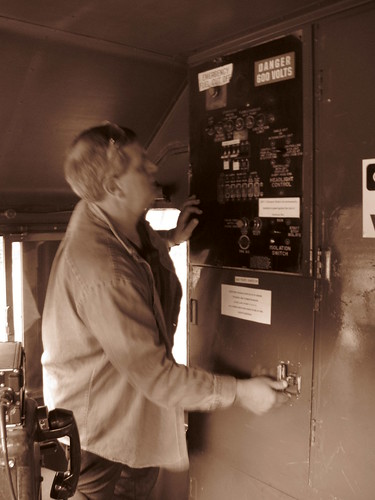
Powering up BB7 for the return trip.

Inside the Blue Ridge Tunnel.
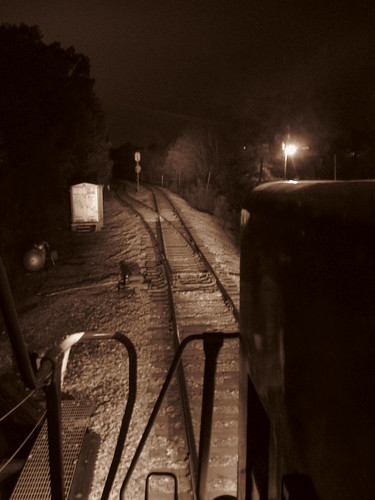
Back at Brand.
More Photos [click to view].
Waterways Preceded Wheels
[click to read]
The oldest transportation canals in North America were constructed by Native Americans in Florida and Alabama, 1,400 years ago. In Virginia, there is no evidence of any canal prior to the arrival of European colonists. Canals were built in Virginia for two main reasons: waterpower and transportation. The smallest of the canals, designed to provide mechanical energy from falling water, were simple ditches and flumes connecting millponds/creeks to gristmills. East of Tidewater, topography-conscious colonists found places to build mills. West of Tidewater, there was enough topographic relief for falling water to power gristmills on nearly every perennial stream. Milldams in the creeks replaced the beaver dams, diverting water into millraces. Waterwheels at hundreds of grist mills were powered by a small, artificially-channeled flow of falling water that then rejoined the natural stream channel downstream of the mill. The millponds captured sediment from farm operations upstream, and blocked passage of both fish and boats, so the initial stream alterations interfered with transportation. In some cases, the canal building was for waterpower, but most of the money was focused on creating canals for transportation.
The main geographic rivalry was between advocates of improving transportation up the Potomac River through the Chesapeake and Ohio (C and O) Canal vs. supporters of improving transportation up the James River via the James River and Kanawha Canal. The goal was to steer western trade through the ports of Alexandria and Richmond. While business from Piedmont and Shenandoah farmers was desireable, the big prize was the business from the Ohio River Valley. As Americans moved west across the Allegheny Mountains, they ended up in the Mississippi River watershed. Roads were poor, and wagons pulled by horses and mules could carry only a limited amount of material, but boats could float grain, lumber, whiskey, hides, and other western products downriver to New Orleans. Eastern seaports wanted to divert that traffic across the mountains to the Atlantic Coast. The C andO Canal, as planned, would have offered a water route from Pittsburgh to Alexandria. The James River and Kanawha Canal would have intercepted the Ohio River further downstream, at Point Pleasant, and sent traffic to Richmond. Both transportation initiatives were planned initially as a series of skirting canals that would bypass the main falls/rapids (such as Great Falls) while requiring boats to rely upon water in the main river channel for most of the distance - and both grew in ambition to be totally separate channels, parallel to the rivers, with expensive locks to manage the changes in elevation. Richmond and Alexandria were not the only cities in Virginia with dreams of using canals to increase the economic "hinterland," the backcountry farming region that traded through a Chesapeake Bay port. In Fredericksburg, the Rappahannock Navigation Company tried to build a canal network 50 miles upstream of the Fall Line to the Blue Ridge, so farmers in the Rappahannock River watershed would do business with Fredericksburg merchants. Construction started in 1829, and proceded slowly. The Rappahannock Navigation Company lacked the resources to build a separate channel next to the river. Instead, it sought to build a series of locks and dams so batteaux (river boats) could float down the Rappahannock River, but bypass the shallow sections via locks adjacent to the river. After a rebuilding initiative in 1847-49, the infrastructure consisted of 80 locks (26 built of stone), 20 dams, and 15 miles of canal. As described in the nomination to the National Register of Historic Places: “A batteau lock-and-dam navigation represents a compromise, typical in the South, between an expensive continuous canal for horse-drawn canal boats, and an inexpensive but unreliable riverbed sluice navigation for batteaux. Batteau, sturdy river boats requiring shallow water, were poled and rowed so they needed no towpath, and could use small locks and narrow canals. the lock and dam system, consisting of a series of dams, each with a lock and usually a short canal, bypassed rapids and created ponds of still water. Most of the inland navigations in the South, penetrating the piedmont by way of the river valleys, were for batteaux. These systems involved various proportions of channeled riverbed (sluice navigation), land-and-dam navigation, and continuous canal.” By 1855, the Rappahannock Navigation Company was bankupt. The Fredericksburg Water Power Company converted a portion of the navigation canal into a waterpower supply for mills in the city. The power company built a wooden crib dam across the river to divert a steady supply of water to the mills, then replaced that dam in 1910 with the taller concrete Embrey Dam. The waterpower canal still transported water from the river after 1910, but now it delivered it to the Embrey Power Plant. The hydropower plant generated electricity for approximately 50 years, before being shuttered in the 1960's.In Richmond, the transportation and power canals developed as parallel projects. George Washington, a strong advocate of transportation improvements that would link the Ohio River valley with port cities on the Atlantic coast, supported the James River Company's efforts to build a transportation canal that would bypass rapids and low water spots that affected shipping down the James River. Business leaders in Richmond built a second power canal closer to the river; the Haxall Canal provided waterpower to mills rather than transportation services.
Transportation canals were "internal improvements" that spurred intense regional rivalries in Virginia. Government approval of charters for canal corporations, and investment of public funds in specific canal projects, forced governors and members of the General Assembly to find a balance between support for canals in the James River vs. Potomac River watersheds. The basic challenge was that river improvements would benefit just a narrow group of people who lived near a proposed canal project, or in the city to which the canal would steer trade. If government support for a transportation project made it easier to ship goods to Richmond, then Alexandria (and Petersburg, Fredericksburg, and Norfolk...) were jealous. Public funds spent to improve transportation in the Potomac River watershed did nothing to reduce transportation costs in the middle of the state; why should Nelson County taxpayers support a canal that would benefit farmers in Loudoun County or merchants in Alexandria? The politicians solved the problem by supporting investment in "internal improvements" across the entire state. The Dismal Swamp Canal is the oldest operating canal in the United States, with traffic starting in 1804 and continuing today as part of the Atlantic Intracoastal Waterway. The canal benefited Norfolk, Portsmouth, and Suffolk, as well as farmers in North Carolina seeking access to the Chesapeake Bay ports. The canal crossed the watershed divide between the Elizabeth River and the Pasquotank River in North Carolina - but builders originally ignored the subtle topography. To maintain a water level high enough to float boats, locks were built near the Virginia/North Carolina line and a ditch was constructed westward to obtain water from slightly-higher Lake Drummond: Early on, the canal supporters believed that the entire region was quite flat; therefore, the canal would be nearly a river-level route, not summit level. They were wrong about this and also about the supposition that because the canal was built in a "swamp" there would be a plentiful supply of water. Droughts proved this wrong. The General Assembly, through the Board of Public Works after 1816, bought stock in various transportation projects in an early version of "public-private partnerships." The state provided up to 60% of the financing for some projects. The state was less interested in Alexandria, which had been transferred to the Federal government in 1801 for inclusion within the District of Columbia. Town merchants had to finance, without Board of Public Works assistance, the construction of the Aqueduct Bridge and extension of the Chesapeake and Ohio Canal to Alexandria. The Alexandria Canal was constructed between 1841-43. Only in 1847, when Alexandria was "retroceded" back to Virginia, did the General Assembly agree to purchase Alexandria Canal bonds. The upstream residents of the James River valley, and especially the citizens of Richmond, were the primary beneficiaries of the James River and Kanawha Canal project. Residents in Culpeper, Orange, and other upstream counties - and of course Fredericksburg - planned to gain from the Rappahannock River Canal. Enhancements to the Appomattox River would benefit Petersburg and the upstream residents in that watershed. The upstream residents in the Potomac River valley, plus the residents in Alexandria, would benefit from the Potowmack Canal and its successor, the Chesapeake and Ohio Canal.mCanals were farm-to-market transportation systems, with the primary beneficiary being the port city at the downstream end. The most intense sectional rivalry affecting state investments in canals was between the communities in the James River watershed (with a canal terminating in Richmond) vs. those in the Potomac River watershed (with a canal terminating in Georgetown/Alexandria). Canals in both watersheds were designed to rival the Erie Canal in New York. Both were planned to connect with the Ohio River, so Midwestern farmers could do business with merchants in Virginia ports rather than with New York City. The James River Company - and the later James River and Kanawha Canal - in the James River watershed provided no economic benefits directly to Virginians living near the Potomac River or the northern Shenandoah Valley. The Potowmac Canal - and the later Chesapeake and Ohio (C&O) Canal - in the Potomac River watershed helped farmers in the lower Shenandoah Valley and the merchants of Alexandria, but took potential business away from Richmond.
George Washington was an advocate for the Potomac River connection with the Ohio River, but he too felt obliged to express support for improving the James. The elected officials in Virginia balanced the state's investments in the two canals in the Potomac River and the James River watersheds. This created a sufficient coalition in the General Assembly to overcome resistance from others regions that would gain nothing, such as Tidewater plantations that already had easy access to transatlantic shipping. George Washington in particular dreamed of the Chesapeake and Ohio Canal and other transportation projects uniting different sections of the new, still-fragile United States. He and his allies viewed canals as essential transportation improvements not only for reducing shipping costs for farmers east of the Alleghenies, but also for facilitating trading alliances with the new states that would be formed on the west side of the Appalachian Mountains. After fighting in the Revolutionary War to create a new nation, Washington saw his new nation begin to fall apart under the Articles of Confederation. He risked his reputation to fight politically for ratification of the Constitution in 1787-88, but knew that geography shaped destiny. He feared that settlers in the Mississippi drainage would have minimal economic ties to the East Coast. (read more)
The Port of Lexington, Virginia
Zimmerman's Lock on North River Canal
Photos by Bob Kirchman


Before the railroad, the James River Canal served as a route to Western Virginia. Our founders were building a network of canals before the steel rails came.
In the late Eighteenth Century, men like George Washington saw the need for a young nation to have infrastructure. Washington and others would oversee the building of the James River and Kanawha Canal, eventually hoping to create a water link to the Ohio River and the Mississippi. The Maury and James Rivers were already used for commerce to the coast by bateaux. These disposable boats would be built for a one way trip downstream and the trip could be described as a combination of white water canoeing in a cargo boat and drifting along long sections of flatwater. By 1860 locks on the James and the North River (now the Maury) allowed canal boats to be drawn by mules upstream to Lexington. The boats were as large as 90 feet long and some had passenger accommodations.

Canal boats in Richmond, Virginia. Drawing by J. R. Hamilton
But the era of canals would be short lived. In Ellicott City, Maryland in 1830 and Charleston, South Carolina, the first steam engines would be proved on fledgling railroads. By the middle of the Nineteenth Century, Claudius Crozet and 2000 Irish tunnel builders would establish a viable railroad through the Blue Ridge Mountains. Soon it would wind its way through the Allegany Mountains. Waterways would not connect the East to the Mississippi.
Railroads soon cut along the banks of rivers, often using the old canal towpaths, but the locks from the old canals remain in many places. The stonework is beautiful and precise. The builders obviously created a work to last for the ages. As the Baltimore and Ohio Railroad built a branch South into Lexington, the engineers of that road would build fine stone viaducts in the same tradition. Many of those remain as well including a beautiful multi-arched one just South of Staunton, Virginia which may be seen from Interstate 81.
Concrete rivers carry the commerce of our day but it is good to remember that our founders saw this commerce as essential to a nation at its beginning.

Photo of a canal boat.

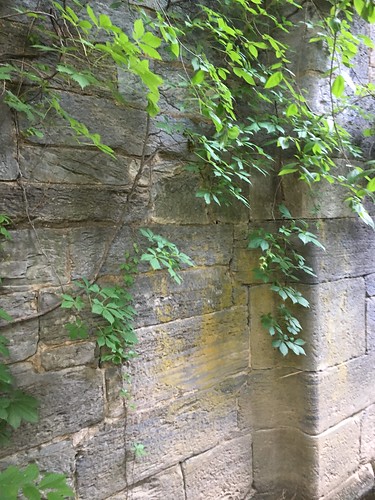
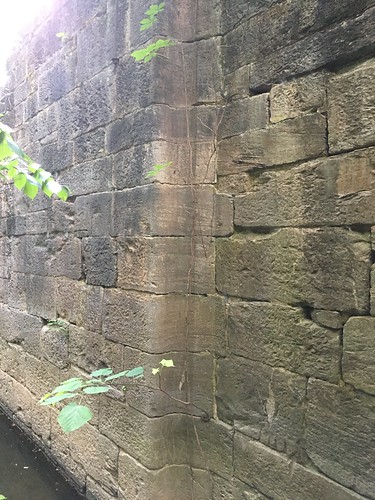
Zimmerman's Lock on the Maury River. The gates opened back into these recesses in the lock walls.
Baltimore and Ohio Railroad
Stone Bridges Built to Endure
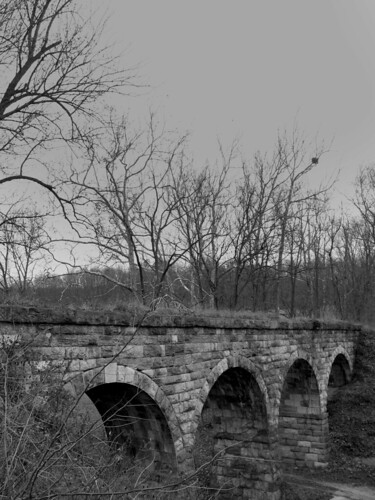
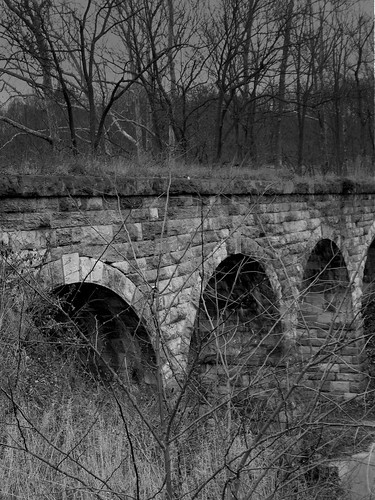
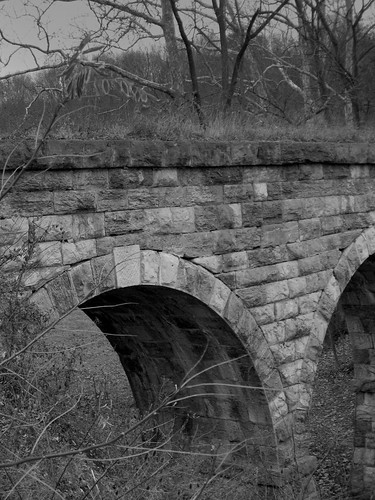
The Valley Railroad, a branch of the Baltimore and Ohio, once ran all the way to Lexington, Virginia crossing this fine stone bridge. Photos by Bob Kirchman.
Although American railroads became known for wooden trestles and iron bridges, it is worth noting that the engineers of the Baltimore and Ohio Railroad built fine stone bridges with smooth roman arches in the early days of the railroad. Two particularly fine examples are this bridge near Staunton, Virginia and the Thomas Viaduct on the road between Baltimore and Washington DC which still carries trains today.
The Thomas Viaduct spans the Patapsco River and Patapsco Valley between Relay and Elkridge, Maryland, USA. It was commissioned by the Baltimore and Ohio Railroad; built between July 4, 1833, and July 4, 1835; and named for Philip E. Thomas, the company's first president.
At its completion, the Thomas Viaduct was the largest bridge in the United States and the country's first multi-span masonry railroad bridge to be built on a curve. It remains the world's oldest multiple arched stone railroad bridge. In 1964, it was designated as a National Historic Landmark.
The viaduct is now owned and operated by CSX Transportation and still in use today, making it one of the oldest railroad bridges still in service.
This Roman-arch stone bridge is divided into eight spans. It was designed by Benjamin Henry Latrobe, II, then B and O's assistant engineer and later its chief engineer. The main design problem to overcome was that of constructing such a large bridge on a curve. The design called for several variations in span and pier widths between the opposite sides of the structure. This problem was solved by having the lateral pier faces laid out on radial lines, making the piers essentially wedge-shaped and fitted to the 4-degree curve.
The viaduct was built by John McCartney of Ohio, who received the contract after completing the Patterson Viaduct. Caspar Wever, the railroad's chief of construction, supervised the work.
The span of the viaduct is 612 feet (187 m) long; the individual arches are roughly 58 feet (18 m) in span, with a height of 59 feet (18 m) from the water level to the base of the rail. The width at the top of the spandrel wall copings is 26 feet 4 inches (8 m). The bridge is constructed using a rough-dressed Maryland granite ashlar from Patapsco River quarries, known as Woodstock granite.[6] A wooden-floored walkway built for pedestrian and railway employee use is four feet wide and supported by cast iron brackets and edged with ornamental cast iron railings. The viaduct contains 24,476 cubic yards (18,713 m3) of masonry and cost $142,236.51, an estimated $2,769,917.36 in 2007 dollars. [Wikipedia]
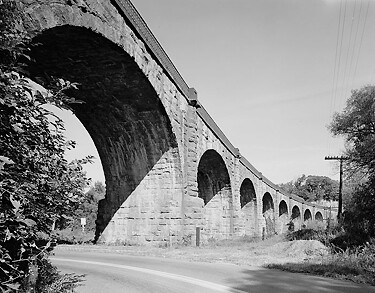
The Thomas Viaduct across the Patapsco River. Library of Congress Photo. [1.]
Riding Railroading's Romantic Beginnings
Wind Power on the Baltimore and Ohio Railroad
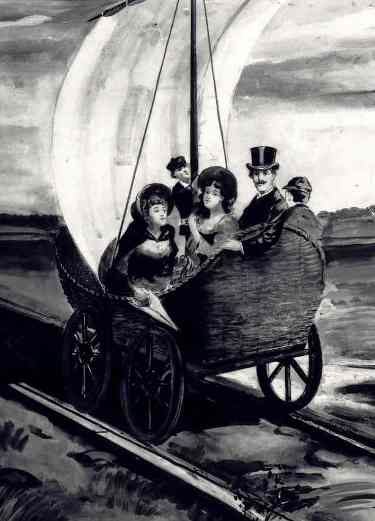
AEolus sails down the Baltimore and Ohio tracks. From the Collections of the B and O Railroad Museum, used with permission.
A recent CSX Transportation radio spot invites canines in cars to "ride the wind, doggies!" It is a reference to the open roads created by CSX trains taking freight off the highways and a doggie's desire to ride in a car with his head sticking out of the open window. Railroading's early days briefly offered another opportunity to "ride the wind" as a unique experiment in motive power took place on America's first operating rail line.
In the early days of the Baltimore and Ohio Railroad, the motive power was provided by horses. The carriages were pulled along the tracks by fine animals selected for this purpose. The building that housed stables and a blacksmith shop in Ellicott's Mills still stands. But horsepower would soon become a standard instead of a literal fact. Peter Cooper's small locomotive with its upright boiler would define the future of railroading. Still, there was a brief period in railroad history where passengers could literally ride the wind.
Evan Thomas of Baltimore constructed an experimental wicker car with a sail which he named the "AEolus." When there was enough wind blowing in direction to make it functional it was operated on the tracks between Baltimore and Ellicott's Mills.
The Russian Ambassador, Baron de Krudner came to observe the operationof the experimental car and actually handled the sail on the trip. He was presented by the President of the railroad with a model of the car. This led to an exchange of American engineers who helped construct Russia's rail system.
The demonstration of Cooper's steam locomotive set the direction for railroad operation. The Fourth Annual Report of the B and O Railroad in 1830 states:
Experience with regard to the celerity of the conveyance of passengers during the preceeding four months on the first 13 miles of the Baltimore and Ohio Railroad, is of the most cheerful and convincing character. The practicability of maintaining a speed of 10 miles per hour with horses has been exhibited. With proper relays,this rate of traveling may be continued through any length of railway, the ascent and descents of which shall not exceed about 30 feet per mile.
Within the last few months, the improvements to locomotive steam engines have been such as to insure their general use on all railways of suitable gradation, and where fuel is cheap." [2.]
Wood and coal would fuel the first boilers. Riding the train could be a dirty experience as smoke and cinders wreaked havoc on the wardrobes of female travelers. Clean coal was used and promoted by the New York Central in this little rhyme:
Says Phoebe Snow
about to go
upon a trip to Buffalo
"My gown stays white
from morn till night
Upon the Road of Anthracite"
The modern railroad saw the use of diesel and electric power. Welded rails and modern track alignment would finally create the illusion of a smooth and effortless glide down the tracks.
21st Century railroads would like to harness the energy of wind farms to power their catenaries [the overhead wires providing power to locomotives], but even now, as during the Nineteenth Century, the winds remain as fickle as they are romantic.
2. The early motive power of the Baltimore and Ohio railroad By Joseph Snowden Bell, p. 5.
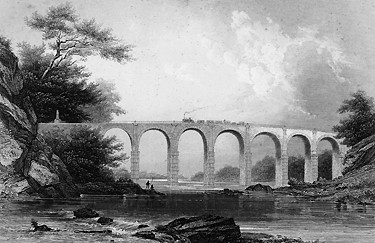
1858 Engraving of the Thomas Viaduct on the then Baltimore and Washington Railroad, a subsidiary of the Baltimore and Ohio.
Engraving from The United States Illustrated, Charles A. Dana, Editor, c. 1858. Retrieved from Historic American Engineering Record; Library of Congress [3.]
Viaduct of the Baltimore and Washington Railroad
from The United States Illustrated, Charles A. Dana, Editor, c. 1858
The traveler may well discern in the viaduct of a railroad, a monumental atonement on the part of surveyors and engineers for the injuries their labors elsewhere inflict upon the picturesque beauty of the landscape. Who has not hailed with delight, upon many a railway, the passage over some viaduct, and welcomed it amid the journey through dust and cinders, as the pilgrim over the African desert welcomes the oasis and its well of crystal water? Underneath, tons of smoothly hewn granite press deeply into the bed of the river, a whiff of whose cooling vapor, at least, comes into the passenger’s nostrils, as he dashes over a superstructure, the length of which would have been the admiration of the Romans, whose creek like Tiber might have provoked the sneer of a “go ahead” engineer.
The “Pons Narniensis,” whose framer was the imperial Augustus; the arches of Trajan over the Danube, and the bridge of Alcántara across the Spanish Tagus, have long been famous in ancient history, whilst America, for the accommodation of no imperial cortege, but of the masses of the people, has rivalled them all in her numerous railroad viaducts, and especially in the Starrucca Viaduct upon the Erie Railroad.
The one given in the engraving was of the first built in the country, although exceeded by the one above named in length, breadth, height, and the span of the arches, it is not surpassed for beauty of location and compactness of execution. But alas, by only one or two of the thousand passengers who rush along its surface, is this beauty and compactness noticed. Now and then a passenger drops off at the neighboring station, intent upon converting his walking staff into a fishing rod, beside the shadow of its arches, or about once in a twelvemonth a detention upon the neighboring “switch” allows the traveller a saunter by its railing, or a hurried clamber down the rocky ledge which confines the waters of the Patuxent (actually the Patapsco) River and in great part forms its bed.” [4.]
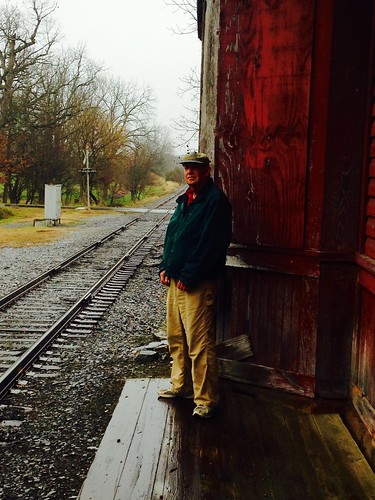
This station at Fort Defiance, Virginia once served the Baltimore and Ohio's Valley Railroad.

Bracket detail of Lexington, Virginia's Baltimore and Ohio Railroad Station, Built in 1883. Photo by Bob Kirchman.
Valley Railroad Bridge
Library of Congress Photos




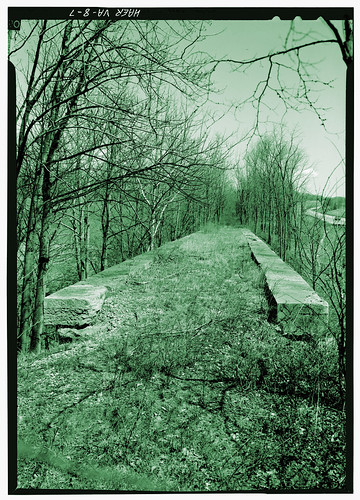

The Valley Railroad Stone Bridge, built in 1874, crosses Folly Mills Creek just west of Interstate Highway 81 approximately five miles south of Staunton. The bridge is a four-span structure with an over-all length of 130 feet and a width of 15 feet, It utilizes semi-circular arches set on gently splayed piers. Slightly projecting imposts are located between the tops of the piers and the spring of the arches. Granite is used throughout as the construction material, and the facing is a rough-surface ashlar. The only change to have occurred to the bridge is the removal of the railroad ties and rails. Because of the close proximity to Interstate 81, the bridge has become a familiar landmark to travelers throughout the Valley of Virginia. The Department of Highways maintains it as part of the highway's landscaping. National Register of Historic Places.
Peter Müller-Munk
The Silversmith Who Designed the Unisphere

Peter Müller-Munk, Industrial Designer.
Today the Unisphere, a twelve story representation of the world balanced above a reflecting pool in Flushing Meadow Park remains as a reminder of the 1964 New York World’s Fair. Most people know that it was fabricated by U.S. Steel in Pittsburgh, Pennsylvania but few people know that the design was created by a German silversmith.
Peter Müller-Munk was born Klaus-Peter Wilhelm Müller on June 25, 1904, in a wealthy suburb of Berlin, in present-day Germany. He began his career as a silversmith, crafting unique and custom silver objects before turning to industrial design. He emigrated to the United States in 1926 and worked as a metalworker at Tiffany and Co. in New York City. He moved to Pittsburgh in 1935 to accept a job at the Carnegie Institute of Technology as assistant professor in the first American university baccalaureate degree program in industrial design. In 1938 he opened his first consulting office in Pittsburgh with Robert Paul Karlen as his first employee. Clients had so expanded by 1945 that he found it necessary to resign from Carnegie Tech to devote himself to his business. At the time, he began operating under the name Peter Müller-Munk Associates with Karlen and Raymond Smith as associates. Anton Parisson became the fifth partner in 1957. In 1956 Ernst Budke became an associate of the firm. By 1960 there were five partners and six associates. PMMA's client list spanned the globe; local ones included the Pittsburgh Plate Glass Company, Westinghouse, and U.S. Steel. Perhaps the firm’s most recognized design is that of the Unisphere, commissioned by U.S. Steel as the iconic symbol of the 1964 New York World’s Fair. After Müller-Munk died in 1967, his work was largely forgotten until the Carnegie Museum of Art mounted a show of his work.

Unisphere. Photo by Guy Percival.
Beyond Peter Müller-Munk
Iconic Representation of the World and Her Children

The BSB Corporation Pavilion at the 2019 Waynesboro World’s Fair. This was a FunDoodle Art Camp project where we built architectural models and photographed them against the sky to give them scale. The pavilion is a concept for an outdoor installation of the ‘Journey to Jesus ‘ Mural created by Kristina Elaine Greer and Bob Kirchman.
For we are God’s masterpiece. He has created us anew in Christ Jesus, so we can do the good things he planned for us long ago.” – Ephesians 2:10 NLT
As a boy, I saw Peter Müller-Monk’s Unisphere and wondered: “What do you do after that to create an Icon for a World Exposition. The delicately balanced steel globe was such a powerful statement. Indeed, I had seen copies of it in a retirement community near Washington, DC and in Santa Cruz, Bolivia (here tilted to give prominence to South America). What could possibly go beyond that?
This past Summer I brought out my World’s Fair lessons for a Summer Camp. I needed to create some ‘sample’ pavilions for the students and I had in my studio a little globe with a base very reminiscent of Peter Müller-Munk’s base for the Unisphere. I set it in a reflecting pool and set to work surrounding it with a copy of the mural ‘Journey to Jesus.’ This was a project that I worked on with Kristina Elaine Greer that showed children around the world coming to the Saviour. The figures were placed in geographical order along a hallway but the work called to be wrapped around the globe!
We had found photographs of children in many lands – often in war-torn places or places of extreme poverty. Once my colleague arrived at our project quite shaken, having found photos of dead children on the internet, so we determined to make the painting about Redemption and Transformation. As we painted closer to Jesus, something happened. I found myself stepping into the background as Kristina came forward. The colors became brighter. The costumes became more vibrant! Transformation! Peter Müller-Munk’s brilliance, at least in part, was that he inspired his colleagues and stepped into the background. He was all about the work, not the recognition.
In the end the work became a statement about God’s workmanship in Redemption. Living Stones fitted into a Divine Design!
The Architecture of the Simon Peter Memorial
[click to read]
By Rodrigo Bollat Montenegro
Imagine what the Vatican and Rome would have looked like today if the popes, architects, and other masterminds of this architectural complex would have designed and built something to only commemorate the tragedy of Saint Peter’s death?
Hypothetically speaking, the obelisk may have remained in its original position on Nero’s Circus, perhaps covered in shards of glass to symbolize “brokenness” and a “call to reflection.” The exact spot where Saint Peter was martyred might become a fountain with the shape of an inverted cross (to be jarring rather than awesome) with the names of all the other Christian martyrs engraved in a metallic material surrounding the water source. From these names, red water would cascade down into a hole in the ground, as if the water carried their souls into an abyss of nothingness.
Hypothetically, of course, the Vatican complex would have looked like a cemetery, but also a park so that future Christians could have utilized the uncontained “space” for recreation, lamentation, and “meditation.” The overall complex would perhaps have been a reconstruction of Nero’s Circus surrounded by reflective glass, as if the resulting glare was a part of the tragic experience of walking through the site at the time of the killings.
Over the centuries, architects who would have fallen out of fashion would have been fired by trend-seeking popes and the populus seeking newness for its own sake. The site would have become a new way to showcase the vogue architect’s latest and greatest reinvention of a glass box. The basilica that has inspired the architecture of countless churches might have become the headquarters of a religion very different than the one we know today. (read more)

St Peter's Basilica / Via della Conciliazione: Basilica begun 1506. Architects: Donato Bramante; façade Carlo Maderna; dome Michelangelo Buonarroti; baroque Gian Lorenzo Bernini. Seen from Via della Conciliazione, built 1936-50, architect: Marcello Piacentini. Vatican City and Rome, Italy. Photo by George Rex.
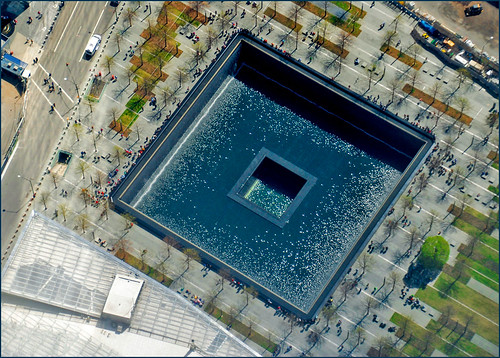
The winner of the World Trade Center Site Memorial Competition was Israeli architect Michael Arad of Handel Architects, a New York- and San Francisco-based firm. Arad worked with landscape-architecture firm Peter Walker and Partners on the design, a forest of trees with two square pools in the center where the Twin Towers stood on the morning of 9/11/2001. On September 11, 2011, a dedication ceremony commemorating the tenth anniversary of the attacks was held at the Memorial. It opened to the public the following day. The square pool shown above represents the site of the South Twin Tower The image was taken from the One World Trade Center Observatory, located at 285 Fulton Street, New York (NY). Photo by Ron Cogswell [1.]
The Voices of September Eleventh

Xaver Wilhelmy's Design for a memorial at the World Trade Center site in New York. The memorial features a 3000 pipe organ to give a voice to everyone who's voice was lost on that terrible day. Rendering by Bob Kirchman
Now imagine, if you will, a different memorial at ‘Ground Zero.’ Instead of two voids, an immense glass chapel – really a pipe organ, where 3000 glass pipes give a ‘voice’ to each soul who’s life was taken on that terrible day. Such was the vision created by Staunton, Virginia organ builder Xaver Wilhelmy. I had the privilege to bring his designs to life in renderings. What would have happened if instead of a sterile plaza there was a memorial that reached to the Heavens both visually and in music? It is something to ponder.
Changing the Culture
[click to read]

In the 1950s, photojournalist Lennart Nilsson set out to capture the earliest stages of existence.
November 27, 2019 (LifeSiteNews) – During last year’s abortion referendum in Ireland, debates, discussions, and interviews about abortion were aired nearly nonstop on both radio and television for the last several weeks of the campaign. I was volunteering with the Save the 8th campaign with a few of my colleagues, and watching the animated late-night brawls over abortion was one of the preferred albeit stressful activities of the pro-life activists after a long day of canvassing. But of all the TV appearances I saw, the one that struck me most powerfully was some comments made on the Tonight Show by John McGuirk, one of the spokesmen for Save the 8th. “My reason for voting no [to abortion] changes on any given day,” he told an uncomfortable-looking panel, “but today it was that I was browsing through the UK abortion statistics for 2016 and I found that eleven babies had lethal injections into their heart in the womb and delivered dead, and the stated reason was that they had a cleft palate. 141 babies had a lethal injection into the heart and were delivered because they were twins and their parents only wanted one child, not two. One of them, last week in Australia actually, there was a story about parents who had one twin aborted because he had a heart defect, and the doctors aborted the wrong one.” McGuirk looked up and went on: “You know, the terrifying thing, Matt, is not that those horrible, horrible, brutal things happened, but that in the UK, they weren’t even a news story. Because when you legalize abortion, you change the culture of a country utterly, you change the way we think about life, you change the way we as a society relate to each other so that absolutely horrifying things can be done behind closed doors to unborn children.” (read more)


Volume XVII, Issue XXIII
A Repeat of One of Our Favorite Issues
Glimpses into a World Unseen
The Amazing Photography of Alexey Kljatov
© 2015 The Kirchman Studio, All rights reserved.
Photographs © Alexey Kljatov, Used by permission.
When I first saw the work of Alexey Kljatov, I was amazed. He takes these stunning images with a simple point and shoot camera rigged with an old macro lens and employing skillful manipulation of lighting. Snowflakes landing on his Moscow window reveal their full wonder and individual beauty through his sublime images. Mr. Kljatov graciously allowed THYME to share his amazing work. You can see more of his photography Here [click to view].
Just imagine the swirling dance of these beautiful shapes in a snowstorm!












Glimpses into a World Unseen
Act II
The electron microscope further reveals amazing patterns.

Vertical section of the human dna.
Evidence of Divine Design, Great and Small
"The Heavens Declare the Glory of G-d;
The Skies Proclaim the Work of His Hands." -- Psalm 19:1

Moth wing pattern.
I saw this little creature outside my studio one morning. It got me reflecting on the creative wonder, both large and small, that surround us.

M 51 Spiral Galaxy, NASA photo from the Hubble Space Telescope.

Detail of the 'X Structure' in M 51, NASA photo from the Hubble Space Telescope.
The artist is amazed. So much beauty and wonder in the very large cosmos and in the very small things as well! Can a G-d who spins galaxies into being be concerned with things small and personal? Such order and grace in the extreme scales of our world, yet often what we see before us is chaotic and makes no sense.
That is why we if you had stepped into that Bethlehem stable many years ago, you would have not necessarily seen beauty and redemption. The smells of animals and the pain of labor and delivery would have overwhelmed contemplation. Yet Christians around the world will contemplate the wonder of that night; for what happened there ultimately made its mark on human history.
Creche at the National Cathedral
A Particularly Beautiful Representation of the Nativity
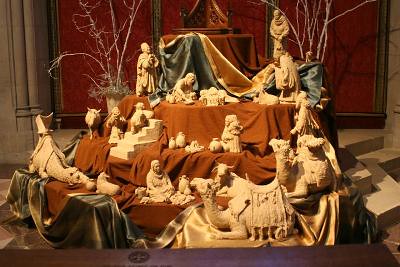
Photo by Kristina Elaine Greer.
University of Virginia Chapel
A Gothic Chapel amidst Jefferson's Classical Village
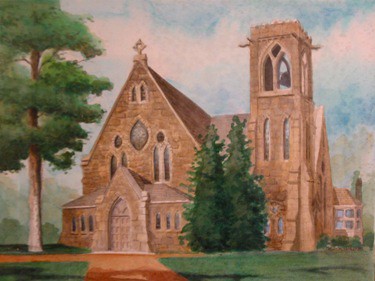
This is my painting of University Chapel. When Jefferson created his academic village it did not have a place of worship. In the late Nineteenth Century members of the Charlottesville community raised the money to build this gothic revival chapel designed by Charles Emmet Cassell of Baltimore. The cornerstone was set in 1885, and the completed chapel was dedicated in 1889. The chapel marks a sharp departure from Jefferson's classical forms. Painting by Bob Kirchman.
Thirty-nine years ago, I stood in this fine Gothic building as I married the love of my life. Thus this historic building is also a part of the story of our own family. It is a story that includes a hike in a rainstorm on Stone Mountain in Georgia and has continued for well over three decades!
One of the greatest challenges to our Faith is our forgetfulness. Scripture reminds us how the people were instructed to remember the great things G-d had done for them. G-d separated the Jordan, as He had the Red Sea, for the people to walk across and gave them the following command:
And it came to pass, when all the people were clean passed over Jordan, that the Lord spake unto Joshua, saying, Take you twelve men out of the people, out of every tribe a man, And command ye them, saying, Take you hence out of the midst of Jordan, out of the place where the priests' feet stood firm, twelve stones, and ye shall carry them over with you, and leave them in the lodging place, where ye shall lodge this night.
Then Joshua called the twelve men, whom he had prepared of the children of Israel, out of every tribe a man: And Joshua said unto them, Pass over before the ark of the Lord your G-d into the midst of Jordan, and take you up every man of you a stone upon his shoulder, according unto the number of the tribes of the children of Israel: That this may be a sign among you, that when your children ask their fathers in time to come, saying, What mean ye by these stones?
Then ye shall answer them, That the waters of Jordan were cut off before the ark of the covenant of the Lord; when it passed over Jordan, the waters of Jordan were cut off: and these stones shall be for a memorial unto the children of Israel for ever. And the children of Israel did so as Joshua commanded, and took up twelve stones out of the midst of Jordan, as the Lord spake unto Joshua, according to the number of the tribes of the children of Israel, and carried them over with them unto the place where they lodged, and laid them down there.
And Joshua set up twelve stones in the midst of Jordan, in the place where the feet of the priests which bare the ark of the covenant stood: and they are there unto this day." -- Joshua 4:1-9
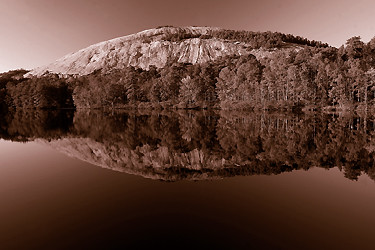


Volume XVII, Issue XXIIV
A Christmas Treasury
Here are presented some of our favorite Christmas features from all time, collected from past issues.
The Life of William Booth
While women weep, as they do now,
I’ll fight
While little children go hungry, as they do now,
I’ll fight
While men go to prison, in and out, in and out, as they do now,
I’ll fight
While there is a drunkard left,
While there is a poor lost girl upon the streets,
While there remains one dark soul without the light of God,
I’ll fight-I’ll fight to the very end!”
– William Booth, Founder of the Salvation Army
Christmas in America, 1783
[click to read]
The year is 1783 and the War for Independence has been won. General George Washington has one last promise to keep: to come home for Christmas. Please join in the celebration of Christmas in America 1783 on The Public Square®! Recorded before live audiences in three cities, this show features classic Christmas music and a compelling true story of faith, love and inspiration right from the front porch of Mount Vernon. Please join Dave Zanotti, Wayne Shepherd and an award winning team of musicians and guests on this year’s episode of Christmas In America on The Public Square®. (read more)
Leaving Your Life Imprint
[click to listen]
Kenny Mauck
Dr. James Dobson once said, "inheritance is something you leave to someone, while a legacy is something you instill in someone." On this broadcast, Dr. Tim Clinton looks at the importance of a godly heritage with author and therapist, Kenny Mauck. The two reflect on their own families' stories and how meaningful Christian lessons were passed down from one generation to the next. (read more)
The Homecoming
For Unto Us a Child is Born
Isaiah 9:6,7
Tchaikovsky's Nutcracker, Op. 71
A Beloved Christmas Story's Story
With Six Children to Feed, the Author Needed a Miracle
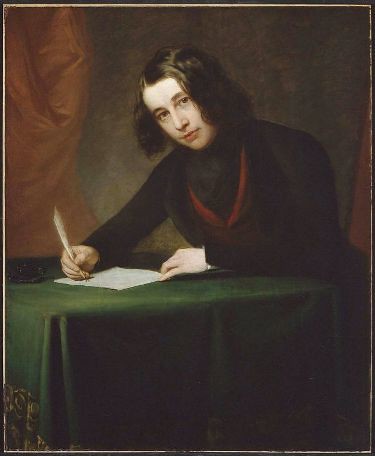
Frances Alexander's 1842 painting of the famous author.
The Year was 1843 and he needed a miracle. With six children to feed and a large house in London to maintain, his slipping sales as a writer were of great concern. His installment novel: Martin Chuzzlewit, was selling poorly, unlike earlier works like Nicholas Nickleby, which had given him some measure of success.
Christmas was coming as he bitterly confided to a friend that his checkbook was empty. Walking the streets, he came up with a 'Ghost of an Idea' and set to work. He published 6000 copies in time for Christmas distribution. They sold out, but because he had splurged on hand-coloured illustrations by John Leech he barely broke even. [1.] Yes, even in Nineteenth Century England, good illustration cost you something! [2.]
Fortunately the little work went on to be a classic. It reinvigorated the career of its creator. Today we still love A Christmas Carol and its author: Charles Dickens, not only as a writer, but as one who helped to bring about much needed social reforms in his day.
Stille Nacht, Heilige Nacht
Beloved Carol Inspired by a Broken Organ
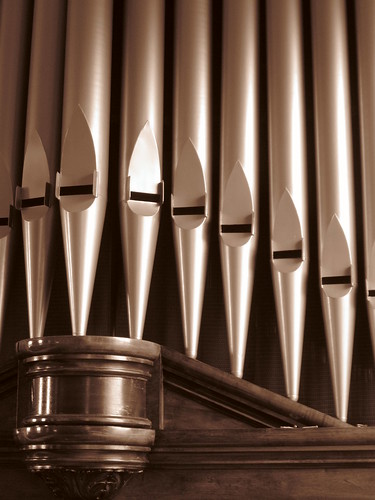
The pipes of the Trinity Lutheran Church organ in Crimora.
Lynn [click to read] brings us the wonderful story of how one of our most beloved carols came to be written:
In 1818, a roving band of actors was performing in towns throughout the Austrian Alps. On December 23 they arrived at Oberndorf, a village near Salzburg where they were to re-enact the story of Christ's birth in the small Church of St. Nicholas.
Unfortunately, the St. Nicholas' church organ wasn't working and would not be repaired before Christmas. Because the church organ was out of commission, the actors presented their Christmas drama in a private home. That Christmas presentation of the events in the first chapters of Matthew and Luke put assistant pastor Josef Mohr in a meditative mood. Instead of walking straight to his house that night, Mohr took a longer way home. The longer path took him up over a hill overlooking the village.
From that hilltop, Mohr looked down on the peaceful snow-covered village. Reveling in majestic silence of the wintry night, Mohr gazed down at the glowing Christmas-card like scene. His thoughts about the Christmas play he had just seen made him remember a poem he had written a couple of years before. That poem was about the night when angels announced the birth of the long-awaited Messiah to shepherds on a hillside.
Mohr decided those words might make a good carol for his congregation the following evening at their Christmas eve service. The one problem was that he didn't have any music to which that poem could be sung. So, the next day Mohr went to see the church organist, Franz Xaver Gruber. Gruber only had a few hours to come up with a melody which could be sung with a guitar. However, by that evening, Gruber had managed to compose a musical setting for the poem. It no longer mattered to Mohr and Gruber that their church organ was inoperable. They now had a Christmas carol that could be sung without that organ.
On Christmas Eve, the little Oberndorf congregation heard Gruber and Mohr sing their new composition to the accompaniment of Gruber's guitar.
Weeks later, well-known organ builder Karl Mauracher arrived in Oberndorf to fix the organ in St. Nicholas church. When Mauracher finished, he stepped back to let Gruber test the instrument. When Gruber sat down, his fingers began playing the simple melody he had written for Mohr's Christmas poem.
Deeply impressed, Mauracher took copies of the music and words of "Stille Nacht" back to his own Alpine village, Kapfing. There, two well-known families of singers — the Rainers and the Strassers — heard it. Captivated by "Silent Night," both groups put the new song into their Christmas season repertoire.
Stille Nacht, heilige Nacht,
Alles schläft; einsam wacht
Nur das traute hochheilige Paar.
Holder Knabe im lockigen Haar,
Schlaf in himmlischer Ruh!
English translation:
Silent night! holy night!
All is calm, all is bright,
'Round yon virgin mother and Child!
Holy Infant, so tender and mild,
Sleep in heavenly peace,
Sleep in heavenly peace.
The Strasser sisters spread the carol across northern Europe. In 1834, they performed "Silent Night" for King Frederick William IV of Prussia, and he then ordered his cathedral choir to sing it every Christmas eve.
Twenty years after "Silent Night" was written, the Rainers brought the song to the United States, singing it (in German) at the Alexander Hamilton Monument located outside New York City's Trinity Church.
In 1863, nearly fifty years after being first sung in German, "Silent Night" was translated into English (by either Jane Campbell or John Young). Eight years later, that English version made its way into print in Charles Hutchins' Sunday School Hymnal. Today the words of "Silent Night" are sung in more than 300 different languages around the world.
The English version we know today was written by the Episcopal priest John Freeman Young, however the standard English version contains just three verses, whereas the German version contains six. (only verses 1, 6 and 2 from the original Joseph Mohr version are sung in English).
The Story of 'Joy to the World'
A Beloved Hymn Written in Celebration of Advent

Graphic by Kristina Elaine Greer, who writes: "I overlaid the entire picture from photos I took of the music in the most recent United Methodist Hymnal. I simply clipped out the music part and compiled them together then cut and pasted them to the template and changed the opacity."
A Short History of 'Joy to the World'
by Kristina Elaine Greer
Most people think of the wonderful hymn, “Joy to the World,” as Christmas Hymn proclaiming the joy of Christ’s birth, but there is a different history behind this marvelous song. The original words to “Joy to the World” by English hymn writer Isaac Watts were based on Psalm 98 in the Bible. According to Wikipedia “the song was first published in 1719 in Watts' collection; The Psalms of David: Imitated in the language of the New Testament, and applied to the Christian state and worship.” Isaac Watts originally wrote the words of "Joy to the World" as a hymn glorifying Christ's triumphant return stated in the book of revelation, instead of as a song celebrating the birth of Jesus Christ. This song was meant more for Advent than Christmas and in some hymnals today you will find it in the holiday concordance of the hymnal under Advent instead of Christmas (which is correct). Interestingly, we only sing the second half of Watts' lyrics when we sing this beloved hymn. The music of this song was adapted and arranged to Watts' lyrics by Lowell Mason in 1839. The melody is said to have been from an older melody, which was then believed to have originated from Handel, partially because of the theme of the refrain (And heaven and nature sing...). This appears in the beloved orchestra opening and accompaniment of the “Comfort ye” from Handel's Messiah, the first four notes match the beginning of the choruses “Lift up your heads” and “Glory to G-d” from the same oratorio. Handel, however, did not compose the entire tune. In fact “Antioch” is the generally used name of the tune. As of the late 20th century, “Joy to the World” was the most-published Christmas hymn in North America. Today we still enjoy it during the holiday seasons of Advent and Christmas time no matter the history it reminds us to be joyful that we have a Savior, who came to earth as a baby, lived among us, died for us, was raised again victorious, and is our Lord who will come again in glorious acclamation.
Unpacking The Twelve Days of Christmas
You Will Never Look at this Song the Same Way Again

"Partridge."
I always assumed the song: "The Twelve Days of Christmas" to be a simple frivolous song of celebration. Not so!, this song is instructive in basic truths of the Christian Faith! Here is the explanation by Father Edward Dowling:
“The Twelve Days of Christmas” celebrates the official Christmas season which starts liturgically on Christmas Day and ends twelve days later on the Feast of the Epiphany. “My true love” refers to God, “me” is the individual Catholic. The “twelve lords a leaping” are the twelve basic beliefs of the Catholic Church as outlined in the Apostles Creed. The “eleven pipers piping” are the eleven Apostles who remained faithful after the treachery of Judas. The “ten ladies dancing” are the Ten Commandments. The “nine drummers drumming” are the nine choirs of angels which in those days of class distinction were thought important. The “eight maids a milking” are the Eight Beatitudes. The “seven swans a swimming” are the Seven Sacraments (or the Seven Gifts of the Holy Spirit) [click to read]. The “six geese a laying” are the Six Commandments of the Church or the six days of creation. The “five golden rings” are the first five books of the Old Testament called the Torah which are generally considered the most sacred and important of all the Old Testament. The “four calling birds” are the Four Gospels. The “three French hens” are the Three Persons in God or the three gifts of the Wise Men. The “two turtle doves” represent the two natures in Jesus: human and divine or the two Testaments, Old and New. The “partridge” is the piece de resistance, Jesus himself, and the “pear tree” is the Cross."
Here is More Historical Background [click to read] from Father Dowling. h/t Kristina Elaine Greer G-d bless you all during the Advent, Christmas, and Epiphany seasons!
Sherando Lake Island and Ice

The island in Sherando Lake. This photo is displayed in the Virginia Blood Services Waynesboro Facility.
Photo by Bob Kirchman
THYME’s ‘Person of the Year’
This will be the last issue of THYME for this year and as the ‘other’ weekly news magazine has chosen their ‘Person of the Year,’ so have we. Our person of the year is probably not on your radar. She’s not sailing across the ocean in a $4,437,240.00[1.] racing yacht. She’s not accusing anyone of ‘stealing’ her future – in fact, she’s too busy building it. I’m talking about the young people who are my personal heroes. They don’t end up in magazine articles (except here), but they are out there every day making this world a better place. They are the young couple I know in the mountains of Virginia who pastor a church and do many creative things to bring the Gospel to their community. Two young women I know who mount their electric wheelchairs every day and create beauty and hope while fighting the effects of Spinal Muscular Atrophy. They are the young students in our art classes who hone their critical thinking skills along with their artistic ability. They are the young nursing student who travels to Guatemala to share her skills helping people in another part of the world and another young woman who is preparing to become an advocate for the aging – along with my most faithful young reader who lives in Kernersville, NC, a man who writes inventive computer programs. They are the young people who are building a bright new world.
Remembering a Special Day
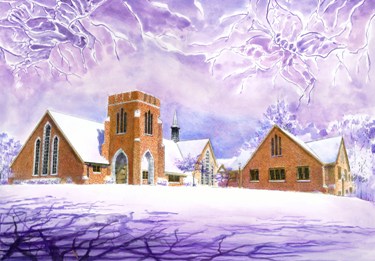
Winter scene, St. John's United Methodist Church in Staunton, Virginia. The painting celebrates the wedding of Kristina Elaine and Jonathan Greer five years ago! Happy Anniversary!
Painting by Bob Kirchman.
